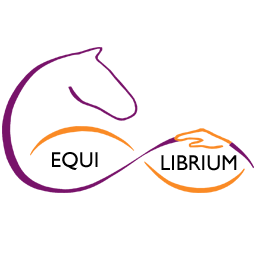Osteopathy
Osteopathy is a self-contained medical system that follows the rules of applied anatomy, physiology and pathology. The equine osteopathy examines the close relationship between the musculoskeletal and locomotor system with all important functional circuits of the body (respiratory system, cardiovascular system, blood circulation, lymph drainage, metabolism and psychological functions). The main objective of equine osteopathy is to locate, eliminate or prevent malfunctions of the body, correct malpositions, and to initiate or support the healing processes of the body. All of this is done by applying gentle manual techniques.
The most important guiding principle of osteopathy: Movement is life.
About symptoms and causes
The body doesn’t always show signs of pain or other disorders to inform us about functional disorders. Our organism is extremely adaptable and is thus able to compensate a lot of malfunctions for quite some time. Malfunctions can be for example poor posture, or muscle tenseness (due to stress or even injuries). Other body parts will take over the tasks of the malfunctioning parts. Due to this mechanism, functional disorders can spread throughout the entire body. So, if you have back pain, the cause doesn’t necessarily have to be found in the back. The back pain could be caused by a problem in your hips. If the underlying cause isn’t treated (or resolves itself in another way), further adaptive or compensatory dysfunctions in other body parts will follow. If these are ignored as well, permanent compensations will take place. This will cause pain. Therefore, blockages should be treated by a specialist – the sooner the better.
As an osteopath, it is my task to find these underlying causes and to eliminate them. I aid the body in activating neurovascular, neuromuscular and neuroendocrine mechanisms of regulations in order to make self-healing possible. Thus, I am basically helping the body to help itself. This is possible, because the body already posses all the healing powers it could possibly need (Principle of Dr. Still). In my work, I start by looking closely at the symptoms before proceeding to the underlying causes. I allocate every dysfunction and its treatment to the other body structures and systems. Finally, I plan an appropriate course of treatment for the particular individual.
Systems of osteopathy
Parietal osteopathy
This branch of osteopathy deals with the musculo-skeletal system (locomotor system). It includes bones, joints, muscles (and its connective tissue), tendons, ligaments and fascia. Specific attention is given to malfunctions of the locomotor system.
Visceral osteopathy
Here special attention is paid to the inner organs, such as the heart, lungs, liver, kidney including the connective tissue, nerves, as well as blood and lymph vessels. Visceral osteopathy focuses on the mobility of the organs and its enveloping or supporting muscles and/or connective tissues. The visceral treatment specifically supports and stimulate the function of the inner organs.
Craniosacral osteopathy
The craniosacral therapy concentrates on the structures of the head (cranial bones, sutures and membranes, the brain, mandibular joint), the spine, spinal cord and spinal fluid, as well as the sacrum. Its objective is the stimulation of the flow of cerebrospinal fluid on the entire organism. You would like to read more?
Fascial osteopathy
This branch of osteopathy is primarily about fascias. Fascias run throughout the entire body. They form shells around organs, muscles, tendons and ligaments (really around anything in the body). By applying specific fascial techniques, painful adhesions between the skin, muscles or fascia can be resolved. Freely moving fascias are the prerequisite for a healthy physiology. You would like to read more?

